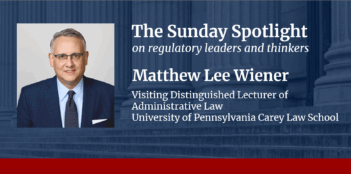
ACUS recommends inviting public participation in rulemaking even when agencies forgo notice and comment.
The Administrative Conference of the United States’s (ACUS) Recommendation 2024-6 addresses the “good cause exemption” from notice-and-comment rulemaking under the Administrative Procedure Act (APA), encouraging agencies to afford meaningful opportunities for public engagement even when invoking the exemption. This recommendation builds on previous guidance issued by ACUS on this topic.
The APA authorizes agencies to invoke the good cause exemption from notice and comment “when the agency for good cause finds … that notice and public procedure thereon are impracticable, unnecessary, or contrary to the public interest.”
An important source for understanding the meaning of the good cause exemption is the 1947 Attorney General’s Manual on the Administrative Procedure Act. Because the U.S. Department of Justice was integrally involved in the design of the APA, shortly after the U.S. Congress passed the law, Attorney General Tom Clark oversaw the preparation of the Manual, which has proved influential in understanding the APA’s terms. Concerning the good cause exemption, the Manual explains “that a situation is ‘impracticable’ when an agency finds that due and timely execution of its functions would be impeded by the notice otherwise required” by the APA. Notice and comment is “unnecessary,” the Manual continues, when an agency issues “a minor rule” that is not of particular interest to the public. Later judicial precedent explains that notice and comment is “contrary to the public interest” only in “the rare circumstance when ordinary procedures—generally presumed to serve the public interest—would in fact harm that interest.”
ACUS has long encouraged agencies to afford the public opportunities for engagement in rulemakings even after the good cause exemption has been invoked lawfully. In 1995, for example, ACUS issued Recommendation 95-4 supporting the use of direct final rules where notice and comment is “unnecessary” and interim final rules where notice and comment is “impractical” or “contrary to the public interest.” A direct final rule is generally understood as one that takes effect automatically following a 30-day public comment period unless significant adverse comments are received, in which case the rule should be withdrawn. An interim final rule takes effect immediately upon publication in the Federal Register or on a date specified by the agency. The agency offers a post-promulgation comment period of at least 30 days (60 days for major rules) and commits to confirming, modifying, or withdrawing the rule in a timely manner after considering public comments.
Recommendation 2024-6 includes several useful additions to past ACUS recommendations. For direct final rules, ACUS suggests that agencies consider publishing a companion proposed rule to serve as a notice of proposed rulemaking if the agency later withdraws the rule because it receives significant adverse comments. If agencies choose to follow this recommendation, ACUS further urges them to provide an additional public comment period.
In addition, ACUS describes two situations in which comments on direct final rules should be deemed significantly adverse: first, comments that explain why the rules would be inappropriate, including challenges to the rule’s underlying premise or approach; and, second, comments that explain why the rule would be ineffective or unacceptable without a change.
When developing an interim final rule, ACUS recommends that agencies explain the issues considered in developing the rule and the reasons for finding that notice and comment is “impracticable” or “contrary to the public interest.” ACUS also suggests a comment period of at least 30 days for most interim final rules, and of at least 60 days for “major rules.”
Finally, ACUS makes clear that agencies, after publishing an interim final rule, should respond to significant comments and publish a final rule “as expeditiously as possible,” while prioritizing major rules. This last recommendation led to debate among ACUS members about the need for a strict deadline for publishing final rules because agencies may lack a sufficient incentive to finalize a rule that is already in effect, often taking years to issue final rules. An agency’s failure to offer a timely response to public comments thus undermines the public engagement process.
ACUS’s 2024 recommendation does not address the circumstances under which agencies may invoke the good cause exemption. Still, ACUS’s ongoing interest in encouraging meaningful participation when agencies use the good cause exemption is timely, especially given the Trump Administration’s aggressive, possibly unlawful use of the good cause exemption.
On April 9, President Donald J. Trump issued a memorandum to the heads of all executive departments and agencies directing them to repeal “unlawful regulations.” To be clear, however, the rules that the President seeks to repeal are not accurately called “unlawful regulations” because they were never rejected by a court. The memorandum states that “the repeal of each unlawful regulation shall be accompanied by a brief statement of the reasons that the ‘good cause’ exception applies.”
Two final rules issued by the Trump Administration highlight the problem. On February 25, the Council on Environmental Quality (CEQ) issued an interim final rule to announce the repeal of the CEQ’s rulemaking authority—and, by extension, rules that have been in place in some form since 1978. The original 1978 rules went through notice and comment, as did the major overhaul of those rules issued during the first Trump term. The Biden Administration restored much of the original rules in 2024, again using the standard notice and comment process.
Now, the Trump Administration has invoked the good cause exemption to repeal those CEQ rules in their entirety, rejecting the agency’s very rulemaking authority without following the APA’s notice and comment process. The Administration claimed “good cause” to be both impractical and contrary to the public interest for two reasons: an alleged need to meet deadlines imposed by President Trump’s executive order on energy regulation and a need to resolve agency confusion created by a lower court decision vacating the CEQ’s 2024 Rule. But the CEQ failed to explain how notice and comment would impede the timely execution of agency functions. Moreover, these conditions do not rise to the level of a “rare circumstance when ordinary procedures—generally presumed to serve the public interest—would in fact harm that interest.”
Then, on April 15, the U.S. Department of Energy issued a final rule—without notice and comment—repealing the definition of “showerhead.” The Energy Department invoked good cause because the President, in an executive order signed earlier that month, directed the Department to repeal the definition. The Energy Department claimed that it had no choice because the President has the constitutional authority to direct rescissions of regulations. These claims, however, fail to satisfy the standards for good cause set forth in the Attorney General’s Manual. Moreover, Congress delegated the authority to set conservation standards to the Energy Department and not to the President. The President does not have the authority to demand the repeal of these regulations.
Litigation over these Trump Administration policies seems all but certain. If nothing else, this litigation should bring clarity to the lawful use of the good cause exemption to notice-and-comment rulemaking.
The views expressed in this essay are those of the authors and do not necessarily represent the views of the Administrative Conference of the United States or the federal government.
This essay is part of a series, titled “Toward a More Accessible and Accountable Administrative State.”




